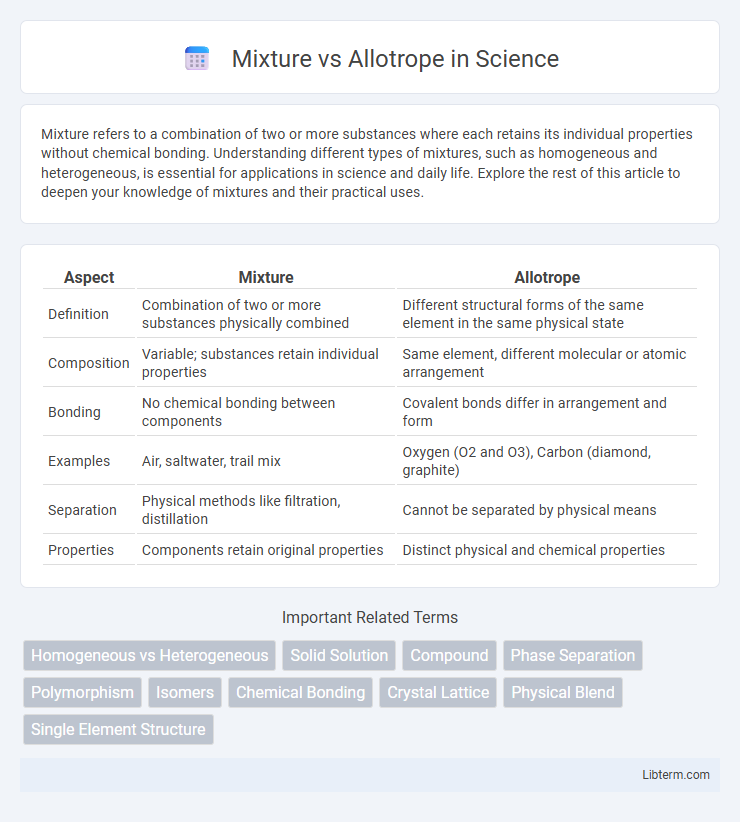Mixture refers to a combination of two or more substances where each retains its individual properties without chemical bonding. Understanding different types of mixtures, such as homogeneous and heterogeneous, is essential for applications in science and daily life. Explore the rest of this article to deepen your knowledge of mixtures and their practical uses.
Table of Comparison
| Aspect | Mixture | Allotrope |
|---|---|---|
| Definition | Combination of two or more substances physically combined | Different structural forms of the same element in the same physical state |
| Composition | Variable; substances retain individual properties | Same element, different molecular or atomic arrangement |
| Bonding | No chemical bonding between components | Covalent bonds differ in arrangement and form |
| Examples | Air, saltwater, trail mix | Oxygen (O2 and O3), Carbon (diamond, graphite) |
| Separation | Physical methods like filtration, distillation | Cannot be separated by physical means |
| Properties | Components retain original properties | Distinct physical and chemical properties |
Introduction to Mixtures and Allotropes
Mixtures consist of two or more substances physically combined, retaining their individual properties and separated by physical means, while allotropes are different structural forms of the same element exhibiting distinct physical and chemical properties. Carbon, as an example, exists as allotropes like diamond, graphite, and graphene, showcasing varied atomic arrangements within the same element. Understanding the fundamental differences between mixtures and allotropes is crucial in chemistry for identifying material compositions and properties.
Defining Mixtures: Characteristics and Types
Mixtures consist of two or more substances physically combined, retaining their individual properties without chemical bonding. They are categorized into homogeneous mixtures, where components are uniformly distributed, and heterogeneous mixtures, where components remain distinct. Examples include saltwater as a homogeneous mixture and salad as a heterogeneous mixture, highlighting the variability in composition and appearance.
Understanding Allotropes: Structure and Examples
Allotropes are different structural forms of the same element, exhibiting distinct physical and chemical properties due to variations in atomic arrangement. Common examples include carbon allotropes such as diamond, graphite, and graphene, each with unique crystal structures influencing hardness, conductivity, and reactivity. Understanding allotropes involves studying these structural differences at the molecular level, which directly affect material characteristics and applications.
Key Differences Between Mixtures and Allotropes
Mixtures consist of two or more substances physically combined without chemical bonding, allowing each component to retain its properties, whereas allotropes are different structural forms of the same element with distinct atomic arrangements. Mixtures can be homogeneous or heterogeneous, while allotropes represent variations like carbon's diamond and graphite forms with unique physical and chemical characteristics. The key difference lies in mixtures involving multiple substances versus allotropes involving a single element existing in multiple structural forms.
Separation Techniques for Mixtures
Mixtures can be separated by physical methods such as filtration, distillation, chromatography, and centrifugation, each exploiting differences in properties like particle size, boiling point, solubility, or density. In contrast, allotropes are different structural forms of the same element with distinct molecular arrangements and cannot be separated by physical methods since they are pure substances. Understanding these separation techniques is essential for effectively isolating components in heterogeneous and homogeneous mixtures.
Allotropy in Elements: Carbon, Oxygen, and More
Allotropy refers to the existence of an element in two or more different physical forms with distinct molecular structures, exemplified by carbon's diamond and graphite, and oxygen's diatomic O2 and ozone O3 forms. This phenomenon significantly impacts the physical and chemical properties of elements, influencing their industrial applications and natural occurrences. Common examples include phosphorus allotropes--white, red, and black phosphorus--demonstrating diverse allotropic behavior beyond carbon and oxygen.
Physical and Chemical Properties Comparison
Mixtures consist of two or more substances physically combined, retaining their individual physical properties such as boiling point and melting point, and can be separated by physical means without altering chemical identities. Allotropes are different structural forms of the same element, exhibiting distinct chemical properties and reactivities due to variations in atomic bonding and molecular arrangement, while their physical properties like density and hardness may also differ significantly. Chemical changes occur only in allotropes during interconversion, whereas mixtures maintain chemical stability throughout physical separation processes.
Real-World Applications of Mixtures and Allotropes
Mixtures play a crucial role in pharmaceuticals, allowing precise combinations of active ingredients and excipients to tailor medication properties. Allotropes like carbon (graphite and diamond) exhibit vastly different physical properties, enabling applications ranging from industrial lubricants to cutting tools. The versatility of mixtures and allotropes underpins advancements in materials science, energy storage, and manufacturing technologies.
Advantages and Limitations of Each
Mixtures offer the advantage of combining substances without altering their individual properties, allowing for easy separation through physical methods such as filtration or distillation, but their composition can vary and lack uniformity. Allotropes exhibit unique physical and chemical properties due to distinct atomic arrangements of the same element, providing diverse functionality in applications like carbon allotropes (diamond vs. graphite), though they cannot be separated by simple physical means and require specific conditions for transformation. Mixture versatility contrasts with allotrope specificity, making mixtures suitable for customizable formulations and allotropes ideal for specialized material performance.
Summary: Choosing Between Mixture and Allotrope
Choosing between a mixture and an allotrope depends on the substance's chemical uniformity and atomic arrangement. Mixtures consist of physically combined components retaining individual properties, while allotropes are distinct structural forms of the same element with different physical characteristics. Understanding these differences is essential for applications in materials science, chemistry, and industrial processes.
Mixture Infographic

 libterm.com
libterm.com